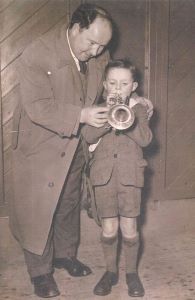THE INDUSTRIAL SCHOOL BAND

by Tom Kenny
In 1852, Fr. Peter Daly purchased the estate of Kilcorkey from the Encumbered Estates Court. The owner of an adjoining site subsequently disputed his title to a particular plot and brought proceedings against him. Peter Daly, however, proceeded to construct on the plot in question a building he described as “A Benevolent Home for aged respectable females whose circumstances would render them unable to afford themselves a comfortable home”. An attempt was made to settle the case out of court but it failed and, in court judgement was given for the plaintiff Miss Grattan Esmonde. She was given possession of the house in August, 1863.
In 1870, a meeting was held to discuss a proposal to establish an Industrial School for boys in Galway and a committee was formed. The Patrician Brothers undertook the management of the school and in June, 1871, agreement was reached with Miss Grattan Esmonde to rent the building. The school was supplied with beds and bedding for 50 boys as well as two suits of clothes for each. On September 25th, 1871, (150 years ago this weekend) “21 poor boys were admitted to the school, most of them in the lowest state of destitution and misery”. In 1876, the Christian Brothers took over the running of the school. By the following year they had built workshops, secured the services of a first-class tailor and a competent shoemaker named Burke, commenced work in the forge, purchased a lathe for the cartmakers shop and formed a school band. Mr. Fulham was paid £20 a year to instruct in instrumental music.

Children went into Industrial Schools for various reasons, some because of poverty, illegitimacy or desertion; others were committed because of offences, very often minor offences. The managers duties were to teach, train, clothe, lodge and feed the boys during the period of detention. The two basic principles of the school were physical caring and training the boys to maintain themselves and avoid destitution by learning vocational skills. There was a great emphasis on neatness, hygiene and order. Routine was rigid, discipline was strict and the school was run on efficient military lines.
A number of local tradesmen complained that the school was doing their type of work at lower rates of pay. The dairy farming section became so successful that local farmers complained. By 1886, there were 200 boys in residence there receiving an education of sorts and being trained in a variety of vocationally-useful skills. They studied farming, shoemaking, tailoring, carpentry, baking, wheelright's work and painting in addition to Christian doctrine, reading, recitation, writing, dictation, arithmetic, singing and geography.
In 1925, the school had 208 boys, average age 11 years of whom 116 were from County Galway, and therefore chargeable to the County Council at 5 shillings per week. An actual proposal was put to the Council to save a shilling a week upon the maintenance of these boys. It would have been an appalling crime for 116 shillings per week. There was uproar.
Many of the buildings around the school were built by the tradesmen who taught in the school. Among those in later years were Mr. Flannelly who taught baking; Tom O'Connor, a wheelright taught carmaking; Mr. McDonald taught shoemaking; Mr. Fogarty-Kelly was a saddler and music master and Mr. Reynolds was a general tradesman, Seán Thornton coached them in boxing.
For most Galwegians, the school band was the only point of contact. In the late 19th and early 20th centuries, The Industrial School Band was an essential feature of sports days, regattas and St. Patrick's day parades in the town. They occasionally played in the bandstand in the park in Salthill. One of their teachers for many years was the distinguished musician and bandleader Johnny Cox. When his parents sadly died, both of them quite young, he and his brothers Jimmy and Paddy all spent some years as residents in the school. He often said he would never have learned to play the trumpet had it not been for the Industrial School Band, and he would never have had the career he did have.
By the time the school closed in the seventies, it had catered for over 3,400 boys and had been staffed by over 500 brothers. Our thanks to Geraldding Buckley for today's photographs.
.png)